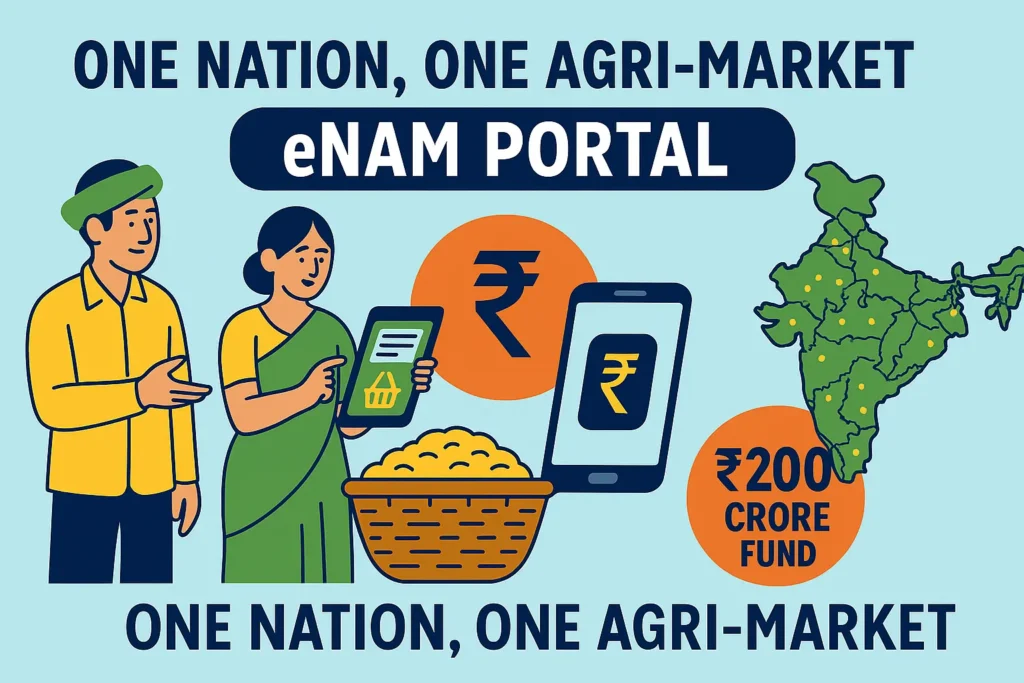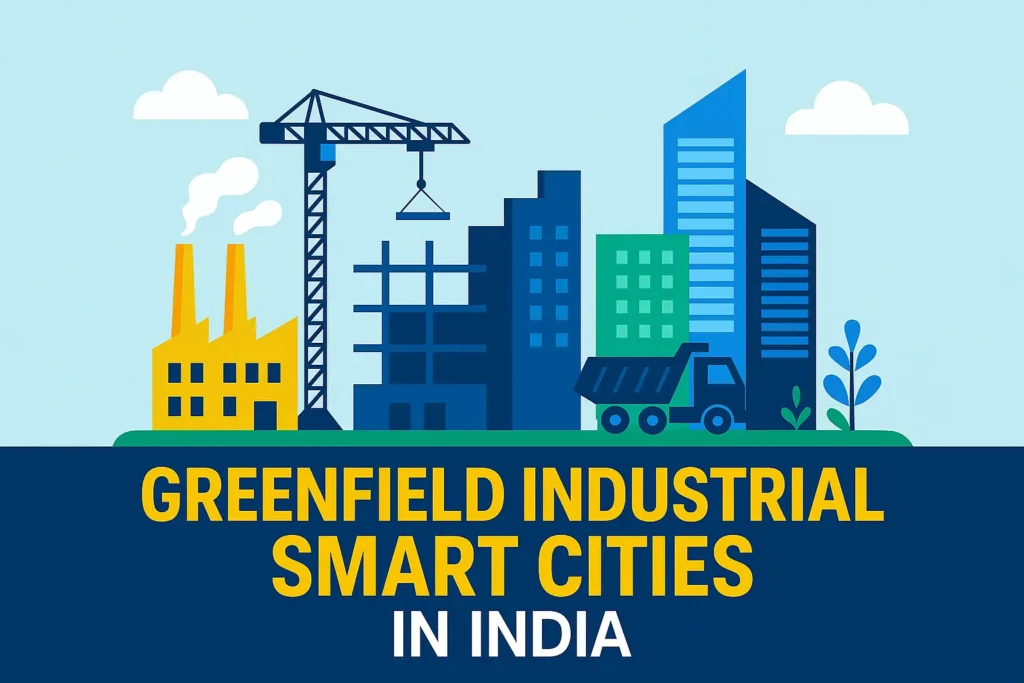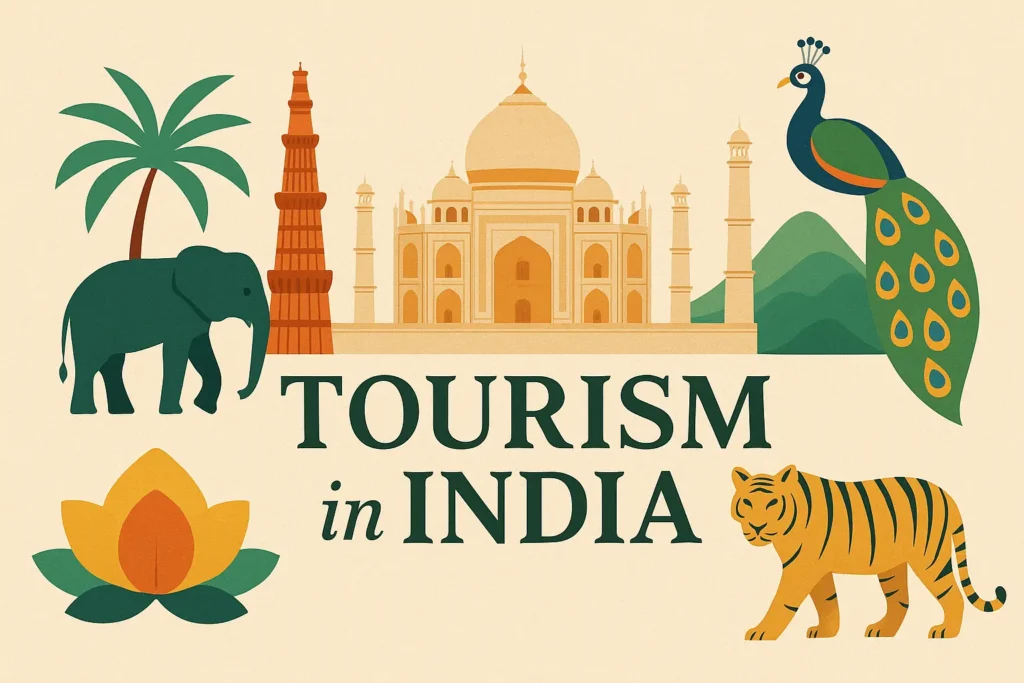e NAM Portal: National Agriculture Market
Table of Contents
The National Agriculture Market (e NAM Portal) is India’s landmark step toward digital agriculture marketing. Launched in 2016, this initiative has revolutionized how farmers sell their produce — ensuring transparency, fair pricing, and quick online payments. Let’s understand everything about the eNAM Portal, its objectives, working model, benefits, and latest updates — in a simple, exam-oriented way.
Launch & Background
- Full Name: National Agriculture Market (eNAM)
- Launched on: 14 April 2016
- Launched by: Prime Minister Narendra Modi
- Nodal Ministry: Ministry of Agriculture and Farmers Welfare
- Implementing Agency: Small Farmers Agribusiness Consortium (SFAC)
- Technology Partner: Nagarjuna Fertilizers and Chemicals Ltd (NFCL) – iKisan Division
The e NAM Portal is a pan-India electronic trading platform that links Agricultural Produce Market Committees (APMC mandis) across states, allowing farmers, traders, and buyers to conduct online trading of agricultural commodities.
By using the eNAM mobile app or computers available at mandis, farmers can directly connect with buyers, removing middlemen and improving price discovery.
Objectives of the eNAM Portal
The main goal of the eNAM Portal is to create a unified national market for agricultural commodities through online trading.
Key Objectives:
- Ensure transparent price discovery and real-time bidding.
- Provide one-nation, one-market for agricultural trade.
- Allow farmers to sell produce online without middlemen.
- Enable inter-state and intra-state trade via a single platform.
- Offer instant payment systems like BHIM-UPI, NEFT, RTGS.
- Integrate grading, assaying, and quality testing at mandis.
How the eNAM Portal Works
The e NAM portal connects farmers, traders, commission agents, and buyers on a single digital platform.
Step-by-Step Process:
- Farmer Registration: Farmers register on the eNAM portal or through the mandi office.
- Produce Entry: Crops are brought to the mandi and digitally entered through the mobile app gate entry.
- Bidding: Buyers place bids online for the listed produce.
- Weighing & Quality Check: Produce is weighed, tested, and graded using AGMARK standards.
- Transaction & Payment: The highest bid is accepted, and payments are made online directly to the farmer’s account.
Key Statistics (as of October 2025)
| Parameter | Data |
|---|---|
| Total Commodities Traded | 247 (including 9 new additions in 2025) |
| Farmers Registered | 50 lakh+ |
| Markets Linked (APMCs) | 1,000 across 18 States & 2 UTs |
| Value of Transactions (2018) | ₹36,200 crore |
| Future Target | Integrate 22,000 GrAMs (rural markets) |
Newly Added Commodities (2025):
Green Tea, Tea, Aswagandha Dry Roots, Mustard Oil, Lavender Oil, Mentha Oil, Virgin Olive Oil, Lavender Dried Flower, and Broken Rice.
Technology Behind eNAM
The e NAM Portal uses cutting-edge digital tools to simplify trade:
- eNAM Mobile App: Available in 8 Indian languages for farmers and traders.
- MIS Dashboard: Monitors real-time data on arrivals, prices, and transactions.
- Integrated Payments: BHIM-UPI, Debit Card, RTGS/NEFT, Internet Banking.
- Gate Entry via App: Farmers can pre-register their produce for quicker access.
- Kotak Mahindra Bank Partnership: Provides clearing and settlement services on eNAM.
These features make the e NAM Portal one of the most trusted digital platforms in India’s agri-market ecosystem.
Geographical Reach
Top States with Most eNAM Markets (as of 2025):
| Rank | State | Number of eNAMs |
|---|---|---|
| 1️⃣ | Uttar Pradesh | 125 |
| 2️⃣ | Gujarat | 122 |
| 3️⃣ | Maharashtra | 118 |
| 4️⃣ | Haryana | 81 |
| 5️⃣ | Madhya Pradesh | 80 |
| 6️⃣ | Telangana | 57 |
| 7️⃣ | Punjab | 37 |
These states are leading in digital mandi adoption, showing how technology is reshaping agriculture at the grassroots.
Objectives and Benefits for Stakeholders
| Stakeholder | Benefits through eNAM Portal |
|---|---|
| Farmers | Direct sale, no middlemen, better prices, faster payment. |
| Traders | Can trade across states without physical presence. |
| Buyers/Exporters | Access to quality produce in bulk from any mandi. |
| Consumers | Stable prices and better quality produce. |
| Mandis/APMCs | Transparent auctioning, automated bookkeeping, reduced manpower. |
Implementing Agency & Fund Allocation
- Lead Implementing Agency: Small Farmers’ Agribusiness Consortium (SFAC)
- Strategic Partner: Nagarjuna Fertilizers and Chemicals Ltd – Ikisan Division
- Funding Support: Department of Agriculture & Farmers Welfare (DAC&FW)
- Grant per Mandi: ₹30 lakh (for platform setup and software)
- Total Fund (Agri-Tech Infrastructure Fund): ₹200 crore
Major Achievements of eNAM Portal
- 1000+ APMCs integrated into a single national network.
- Farmers in 18 states and 2 UTs can sell directly online.
- Introduction of inter-state trading and online payment settlements.
- Transparent price discovery and reduced manipulation in auctions.
- Integration with Soil Testing Labs and AGMARK certification for quality assurance.
Other Major Agriculture Schemes Linked with eNAM
| Scheme | Objective |
|---|---|
| PM Fasal Bima Yojana (PMFBY) | Crop insurance protection |
| PM Krishi Sinchai Yojana (PMKSY) | Irrigation efficiency |
| Paramparagat Krishi Vikas Yojana (PKVY) | Organic farming |
| PM Kisan Samman Nidhi (PMKSN) | Direct income support to farmers |
| Atal Bhujal Yojana | Groundwater conservation |
| Micro Irrigation Fund (MIF) | Efficient water usage in farming |
| Gramin Bhandaran Yojana | Rural storage infrastructure |
Exam-Oriented Facts Summary
| Fact | Details |
|---|---|
| Full Form | National Agriculture Market (eNAM) |
| Launched By | PM Narendra Modi |
| Launch Year | 2016 |
| Ministry | Ministry of Agriculture & Farmers Welfare |
| Implementing Agency | SFAC |
| Funding Source | Agri-Tech Infrastructure Fund (₹200 crore) |
| Per Mandi Grant | ₹30 lakh |
| Number of Commodities (2025) | 247 |
| Latest Addition (2025) | 9 new commodities including Lavender Oil and Broken Rice |
| Mobile App Language Support | 8 Indian languages |
| Tagline (Objective) | “One Nation, One Market for Agriculture” |
| Most Important for Exams | UPSC, APPSC, SSC, State PSC, Agriculture Exams |
FAQs on e NAM Portal
-
What is the e NAM Portal?
The e NAM Portal (National Agriculture Market) is an online trading platform for agricultural commodities that connects APMC mandis across India to enable farmers to sell produce directly to buyers.
-
When was eNAM launched?
The e NAM Portal was launched on 14 April 2016 by Prime Minister Narendra Modi.
-
Which organization implements eNAM?
The Small Farmers Agribusiness Consortium (SFAC) under the Ministry of Agriculture and Farmers Welfareimplements eNAM.
-
What are the benefits of the e NAM Portal for farmers?
It ensures better price discovery, eliminates middlemen, provides faster payments, and enables online tradingof commodities.
-
How many commodities are traded on eNAM as of 2025?
A total of 247 commodities, including Green Tea, Mentha Oil, Mustard Oil, and Broken Rice.
The eNAM Portal has become a symbol of India’s agricultural digitization drive. By connecting farmers directly to markets, it ensures fair prices, transparency, and faster transactions. With continuous innovation — like integrating payment systems, quality testing, and mobile apps — the eNAM platform is transforming India into a “One Nation, One Agri-Market.”
Source: PIB


